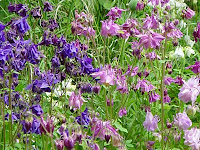I haven't posted for a while, what with the bus-like nature of festivals - and getting a bit distracted by football (COYS!), trying to work out the new Facebook interface, historic elections I couldn't even vote in, and - oh, yeah - some actual gardening! But things have happened since early October...
We have made an attempt to sort out the drainage issue. The otherwise excellent architects of our estate seem to have had a bit of a brain-flip when it came to guttering. They decided, in their wisdom, that each row only needed one downpipe per two houses, and none at all on the ends. During the summer, we discovered the result of this was that every rain shower produced a ridiculous waterfall out of the end of the overburdened gutter, dropping straight down the side of the house, some of it leeching into the brickwork and the rest washing across the patio.
Obviously, we needed a new downpipe fitted. And since it takes around 8 ten-litre cans of metered water to water the garden if it doesn't rain for a couple of days (no, I don't understand how, either), it seemed to make sense to fit a water-butt at the same time. Particularly as, in keeping with the 'one per two houses' thing, there is no accessible drain anywhere around our end of the row - the nearest one being in our neighbour's garden. So we had the gutter adjusted to send most of the water from the roof running to the original downpipe like it's supposed to, and got a new one fitted at the other end to carry excess to a 210ltr water-butt.
And that should have been that - but life is never simple, is it? Firstly, I misunderstood the instructions for fitting the tap, and ended up cutting the hole for it slightly too big, and no amount of sillicone sealant would fix it, so we had to get another one. Secondly, although during the summer, a 210 ltr butt should keep us going for weeks without any trouble (because I'll be taking out the water regularly), at this time of the year, it fills up far too quickly! Then it overflows, and we're back to square one. Although a larger butt would help, our rubbish climate ensures that we'd probably hit the same problem at some point during the winter regardless. Spouse has partially solved the problem by fitting a second tap at the top and attaching a hosepipe to take the water under the fence to the drain next-door (where it would have been going anyway if the gutter worked properly in the first place). This works fine until the point where the rain is heavy enough that the water filling the butt through the downpipe flows in faster than the narrow hosepipe can carry it away. I will have to work on my water management to keep the thing empty enough to avoid future overflows. It doesn't help that the garden is plenty wet enough at the mo, but I do have a thirsty gardenia, a lemon sapling and some windowsill herbs indoors...
Interestingly (to me, anyway!), having watched the overflow from the water butt has given me a clearer idea of what's been happening to the rain run-off from the gutter this summer - before, it wasn't as obvious where it was all going, or how much of it there was. Now, looking at the lawn from the first floor window, I can see a distinct boundary between one corner of the lawn and the rest of it - certain differences in the grass, like the direction the blades bend in, the thickness, the colour, places where it springs back from being raked and ones where it doesn't... and because I know where I put seed down, I know it's not all down to new growth. I think it could be a kind of 'tide line', marking the edge of regular seepage from the patio. If (and it's a big if) I'm right, then it would explain why that particular corner is resolutely soggy, and would mean there's a chance that the crapness of our lawn is not completely down to the shade and the bad soil. Catching all the water that's been keeping it so, um, Scottish might dry it out. So getting the water-butt working properly could bring us one step closer to Spouse's happy piece of parkland!

























